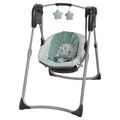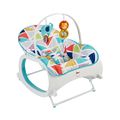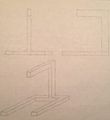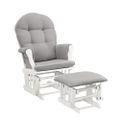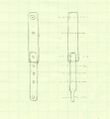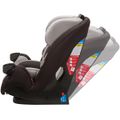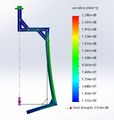Safe vibrating swing
Abstract
Abstract here - a short statement of the need, findings of project and project outcome.
Kolt, an infant with down syndrome, enjoys swinging but is in need of a safer swing that can also be used as a feeding chair. Since the child is on oxygen and also cannot hold his head upright, these needs must also be accommodated in the design. Lastly, the family would like this chair to be able to grow with their child so he can use it for years to come.
Team Members
- Jeff Baker
- Jacob Hayes
- Jonathon Hayes
- Jacob Lawrence
Acknowledge Help of Others
- other
Problem Statement / Overview of the Need
Summary of the Project Need:
Kolt is a six-month-old with down syndrome who enjoys swinging. His mother would like a safer swing that can better secure him to the swing. The swing should also function as a high chair for feeding Kolt, so its height should be adjustable and its position able to be fixed from swinging. After Kolt is fed, he must be reclined at a specific angle; the swing seat should be able to recline to meet this need. Because Kolt currently uses oxygen, the swing must accommodate his oxygen cord in a safe and secure manner. He also has difficulties keeping his head upright, so some form of head restraint would be necessary during feeding. The chair should be able to grow with Kolt so that it can be used for years to come. It would be beneficial to the family if the swing frame could come apart for easier transportation if necessary. In addition, the swing should be compact in size and relatively lightweight because of some space constraints and for mobility from room to room.
Design Specifications
List of Design Specifications. Some quantitative and measurable. Used to compare design options.
- Frame Dimensions (height x width x depth): 5-6' x 3' x 4'
- Overall Swing Weight: no part should exceed 50 lbs
- Swing Strength and Size Capacity: 50+ lbs and 4-foot tall child
- Safety and Comfort: proper seat restraint oxygen cord restraint, and head support
- Adaptability: from infancy to over six years old
- Maneuverability: transportable from room to room
- Eliminate Unwanted Swing Vibration
- Ease of Use and Functionality: adjusting components should be simple and easy to use
Background Research
Existing products, their availability, and possible adaptations to meet necessary gaps in these products
Infant swings on the market are not strong enough or made to change in size as the child grows. An infant swing would be quickly outgrown and adapting an existing swing would be difficult to meet design requirements for size, strength, height adjustment, oxygen cord restraints, and reclining and locking ability while still being safe.
Safe and comfortable child harnesses are available if the decision was made to construct the swing seat ourselves; however, there would be some difficulty in adequately attaching the harness to the rest of the seat in a manner where it is still adjustable for size and is positioned correctly.
Most toddler rocker seats function well but are not made to support the size and weight of a 50 lb child. An existing rocker could be a model for our swing if such a design is acceptable to the family. Rockers on the market have a seat that is fixed to the frame making reclining separately from rocking impossible. A reclining function is not something that could be easily added to a rocker on the market.
Conceptual Design
Summarize your conceptual design process. Develop at least three concepts.
Frame Design Concepts
Concept 1
Description
- This frame design is A shaped for expected rigidity and durability. An A-shaped frame would be very safe and well supported
- The angled legs and supports on each side could take up too much floor space, and the horizontal bar could make it difficult for the parent to feed the child. A support on each side would increase the swing weight considerably and make transporting the swing more challenging.
Concept 2
Description
- A cantilevered frame would be lighter, easier to move, and more open for accessing the child once he is in the swing
- This concept is more susceptible to tipping and is not as strong as other designs
Concept 3
Description
- Rather than swinging, this concept would glide back and forth
- This is the most complicated design due to the mechanism that would allow gliding, and the family may not be interested in the gliding motion rather than swinging
Concept 4
Description
- This design rocks instead of swings. It features stops to prevent over-rotation and a fold-out stop to prevent rotation entirely. A rocker would be more simple in construction, would be the lightest, and take up the least floor space
- The family may rather have the original swing motion than a rocking motion, and this concept would sit low to the floor potentially making moving the child in and out of the swing difficult
Connecting Rod Concepts
Concept 1
Description
- These rods are used to connect the swing mount to the seat. In this design, they will be constructed of a larger and smaller diameter pipe to slide inside each other. Both pieces of tubing will have incrementally spaced holes to allow for different swinging heights. A pin will pass through the sets of holes to lock the rods at a certain length. At each end, there will need to be a welded cap to allow for mounting.
- These could contribute to the weight of the overall swing and introduce a place for bending or shifting where the rods lock together. Connecting to the seat in a way to prevent pinching or rubbing could be challenging
Concept 2
Description
- This swing arm concept would wrap around the seat and one side would be open so that the child would be more accessible once he was in the swing
- To avoid deflection and excess stress, this component would have to made of a strong material which could make the piece heavy and difficult to swing
Seat Concepts
Concept 1
Description
- A self made seat could be tailored to the exact needs of the family
- A homemade frame and seat would be challenging to fabricate and would most likely not function as well as a purchased seat
Concept 2
Description
- A purchased seat would more than likely be safer, more comfortable, and would still meet the needs of the family: head restraint, harness, and reclining function
- It may be difficult to find a seat that meets all of the design requirements in such a way that it would be acceptable to the family. Mounting the seat to the swing could be challenging and not adequate enough
Evaluate Concepts / Select Candidate
Use a decision matrix or similar tool to compare designs against project specifications Discuss winning candidate
Frame
- The family disliked concepts that involved a motion other than swinging (the glider and rocker frames)
- The A-frame concept seems unnecessarily heavy and confining when compared to the additional strength and tipping resistance it would bring
- A cantilevered frame although more prone to tip could still be designed in such a way that it was safe. The open side, added mobility, and reduced weight of this frame were attractive to the family
Connecting Rods
- With the cantilevered frame chosen, it doesn't make sense to cover the added accessibility with a swing rod on each side
- A single swing arm could be designed for the correct amount of strength and limited weight. With this concept chosen, the height adjustment would have to be made on the frame
Seat
- After further research and discussion with the family, we came to the conclusion that there are car seats available that adequately meet their needs.
- A purchased car seat would be much safer and comfortable to the child
Detailed Design
- This section will describe a detailed design process
Our design process began by meeting with Kolt's early intervention service coordinator. We discussed the specific requirements our design needs to meet. These design requirements along with the requirement to swing include a way to adjust the swing height, a locking mechanism to prevent swinging, the ability for the seat to adjust to different positions, a head restraint, safety harness, and oxygen cord restraint. Additionally, the family would like the swing to be able to fold or come apart into pieces for easy transportation and be light enough to be moved across the home either by sliding or rolling.
Once we were aware of the design requirements, we developed design specifications such as frame dimensions and overall swing strength. With design specifications in place, existing swings, seats, and restraints were researched. Conceptual designs were created for the swing frame, swing seat, locking mechanisms, and oxygen cord restraint. Our conceptual designs included an A-frame, cantilevered frame, an on-floor rocker, and an on-floor glider swing.
We presented our conceptual designs and product research to Kolt's family along with his service coordinator. Together, we evaluated how each concept meets the design requirements and narrowed down our designs by prioritizing needs. Strength, comfort, safety, accessibility, and ease of use were the primary concerns of the family. With these things in mind, the decision was made to build a cantilevered frame with a purchased car seat to be used to meet the safety and reclining requests.
After a conclusion was reached on our final design, we modeled our design and performed finite element analysis (FEA) on the swing frame. Calculations were also made to find overall product weight and tipping point. Each of these analysis reinforced our design decision before moving forward into construction.
Description of Selected Design
The swing will have a number of components: a cantilevered frame, swing arm, seat frame, and a purchased seat. When assembled, the swing will follow a one dimensional path normal to the cantilever arm of the frame. The locking mechanism will be incorporated into the swing arm. The height adjustment will be done by the frame itself
Detailed Description of Selected Design
Frame- The swing frame will be cantilevered to allow one side of the swing to be left open for accessibility to the swing. A cantilevered frame maintains the strength required to support the weight of the swing and the child now and into the future. The swing frame will be constructed of steel square tubing. The dimensions of our frame (5'x 4'x 3') will prevent tipping. In order to further prevent tipping, the top bar from which the swing will hang from will only partially extend the dimension of the overall frame width. For ease of transportation, the frame will have a set of wheels and will disassemble into three manageable pieces. Regularly spaced holes will make the two pieces of the frame capable of adjusting to different heights
Swing Arm/Seat Frame- The swing arm and seat frame will be constructed of steel square tubing. Upon finalizing our design, the decision was made for the swing arm and seat frame to be one piece. A one piece construction will ensure the swing does not twist and a single motion will be maintained across the swing path. The swing arm will wrap around the seat with one side open so the seat can be easily positioned onto the seat frame and so that taking Kolt in and out of the seat is as easy as possible. The swing arm will be mounted to bearings on the frame. Passing a pin through the swing arm is an easy but effective way to lock the swing into the down position. To allow the seat to be positioned and removed easily, the seat will be secured on top of the seat frame.
Seat- The swing seat chosen in our design will be a car seat. Upon evaluating the different design requirements needed for the swing seat, a fabricated seat would be very difficult to fabricate and likely under-perform when compared to a purchased seat. The purchased car seat will be safe, comfortable, restrain Kolt correctly, and will also be able to grow with him and recline as needed. The seat will be implemented into our design unchanged to allow the family to use as a functioning car seat.
Analysis
Describe three types of analysis to be performed on the design
Engineering Analysis 1
Frame Stress Analysis
This analysis attempts to model the stresses of the cantilevered portion of the frame under a weight of 200 lbs applied to the end.
Engineering Analysis 2
Frame Deflection Analysis
This analysis attempts to model how the cantilevered portion of the frame will deflect under a weight of 200 lbs applied to the end.
Engineering Analysis 3
Swing Arm Stress Analysis
This analysis attempts to model the stresses subjected under a 200 lb load applied vertically downward.
CAD Drawings
Insert drawings of all parts and the assembly
Bill of Materials
qty, item, description, source, part number, price
$279.99 1 Britax Marathon ClickTight Convertible Car Seat (color): Oasis https://us.britax.com/marathon-clicktight-convertible-car-seats/#aSpecs
$72.72 24 feet 1-1/2 X 1-1/2 X 11 GA (.120 wall) A513 Square Steel Tube. https://www.metalsdepot.com/steel-products/steel-square-tube?product=1251
$24.48 Steel Telescoping Square Tube 1-3/4" x 36"-Long x .105" Wall https://www.industrialmetalsales.com/Steel-Telescoping-Square-Tube-1-3-4-x-36-Long-2448-SteelTele1750x36x105w.htm
$11.08 2 Heavy Duty Rubber Caster Wheels with Rigid Non-Swivel Top Plate - 2-Inch - 125 lb. Load Capacity https://www.amazon.com/Heavy-Rubber-Caster-Wheel-Non-Swivel/dp/B0083MQVD2/ref=sr_1_5?s=industrial&ie=UTF8&qid=1540999989&sr=1-5&refinements=p_n_feature_six_browse-bin%3A3006855011
$89.70 7 feet of 1-1/8 OD x .156 wall x .813 ID 1020 DOM A513 Round Steel Tube https://www.metalsdepot.com/steel-products/steel-round-tube-dom
$9.91 12" x 12" x 0.125" (11 GA) ASTM A1011 HOT ROLLED STEEL SHEET https://www.onlinemetals.com/merchant.cfm?pid=9882&step=4&showunits=inches&id=839&top_cat=0
$17.16 8 feet of 3/4 X 3/4 X 14 GA (.083 wall) A513 Square Steel Tube https://www.metalsdepot.com/steel-products/steel-square-tube?product=1254
Assembly Instructions
Fabrication Process
Insert pictures of fabrication process
Testing and Implementation
Describe testing, delivery, how used/received by the family
Throughout the fabrication process, different components were inspected for safety in handling and strength. Components critical to the structure of the swing were subjected to loads beyond that which is expected in its function. The swing frame and swing arm were each loaded in excess of 150 lbs and then examined.
The pieces of the swing all fit in the back of a pickup truck that was drove to the family. Once we arrived, the swing was assembled in the home and all areas of concern and safety precautions were described. Any questions by Kolt's mom were answered.
Photos of Completed Design
Insert pictures of the final product
Instructions for Safe Use
Provide a clear summary of safe use for the family.
This swing should only be operated with the designed car seat in place and with both seat belts in place and tightened. The swing is not intended for large angles of swing. Never attempt to adjust the car seat or swing height with the child in the car seat. Always follow the car seat manufacturer's instructions and guidelines. Do not use the device unless supervised by an adult that has been fully understood the safe use of this product.
Project Summary and Reflection
Provide reflection on project outcomes here
This project has been very rewarding. Being able to follow the engineering process from start to finish is a great experience in becoming an engineer. Also, it is great to work in the machine shop and gain important skills. Knowing the process of fabrication helps in the design process when considering what can and cannot realistically be done when manufacturing. This is something that we should have considered more. Challenges arose during fabrication which may have been more easily avoided if more consideration to fabrication had been given during the design process. Overall, all the time and energy spent on this project were well worth it after seeing the smile on our child's face.

